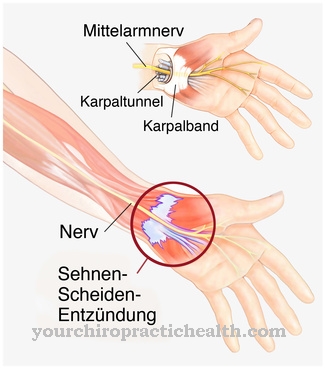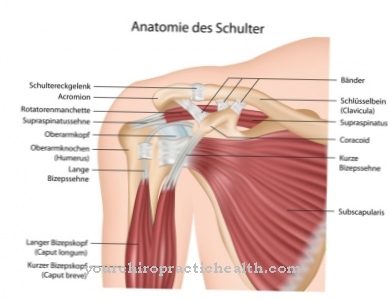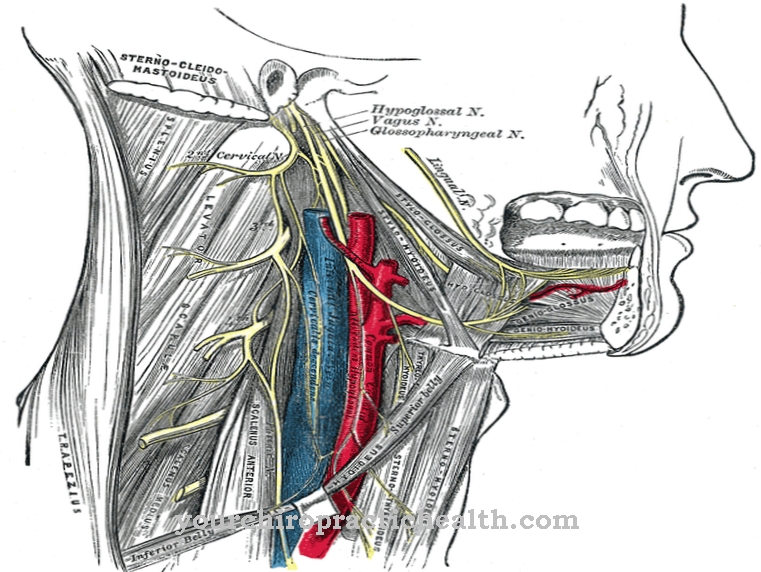Of the Scalenus medius muscle is the longest scalene muscle and is included in the neck muscles and auxiliary respiratory muscles. The skeletal muscle is also called middle rib lifter denotes and enlarges the thorax with bilateral contraction to facilitate forced inspiration. With the anterior scalenus muscle, the muscle forms the scalenus gap, which is becoming more pathological in the context of the scalenus syndrome.
What is the Scalenus Medius Muscle?
The neck muscles, or ventral neck muscles, are made up of various skeletal muscles that contribute to the anterolateral muscle mass of the neck. Neck muscles are sometimes also called the neck muscles, which basically belong to the back muscles. One of the skeletal muscles in the neck is the scalenus medius muscle.
The Latin adjective "scalenus" means something like "unequal" or "crooked" and thus already relates to the morphology of the neck muscle. The scalenus medius muscle is better known as the middle rib support muscle. The musculus scalenus anterior, which is also part of the neck muscles and together with the musculus scalenus medius, forms the so-called scalenus gap is to be separated from the middle rib support. There are a total of three muculi scalene. The third scalene muscle is the posterior scalenus muscle. All three scalene muscles are called hypaxial skeletal muscles and are located in the thoracic region. Each half of the body is equipped with a central rib lifter.
Anatomy & structure
The origins of the scalenus medius muscle correspond to the transverse processes of cervical vertebrae. More precisely, these are cervical vertebrae three to seven. In most cases, the middle rib holder starts at the first or second rib. From here the muscle runs dorsal to the subclavian artery and occasionally also attaches to the outer surface of the ribs.
The scalenus medius muscle is the longest scalenus muscle in human anatomy. Between the middle rib support and the shorter anterior scalenus muscle, there is a space that is also known as the posterior scalenus gap. At this point, the subclavian artery passes through the brachial plexus to enter the axilla. The innervation of the musculus scalenus medius is taken over by the anterior branches of various spinal nerves. More precisely, the spinal nerves from the spinal cord segments C4 to C7 are involved in the innervation of the neck muscle.
Function & tasks
The musculus scalenus medius makes essential contributions to the motor skills of the neck. The muscle moves the neck to one side during unilateral contractions. This means that the central rib lifter inclines the cervical spine when there is one-sided contraction. On the other hand, if the skeletal muscles contract on both sides of the body, the neck is pulled down. The contractions of the muscle not only affect the neck motor skills, but also have an influence on the general trunk motor skills.
In particular, the bilateral contraction of the skeletal muscle changes something in the morphology of the trunk and thorax. As part of the bilateral contraction, the scalenus medius muscle lifts the upper ribs. This connection has helped the muscle to be referred to as the "middle rib lifter". The thorax changes automatically due to the raised ribs. First and foremost, the bony thorax increases in volume through muscle contraction. Like the other two scaleni muscles, the scalenus medius muscle is part of the auxiliary breathing muscles that take on important tasks in the context of inspiration.
The anterior scalene muscle, for example, lifts the first rib when contracted on both sides and the cervical spine is fixed, which also causes the thorax to expand. The musculus scalenus posterior supports the expansion of the bony thorax during bilateral contraction and the musculus scalenus medius expands the bony thorax when inhaling by contracting on both sides. Like all other components of the inspiratory auxiliary breathing muscles, the scalenus medius muscle supports breathing when the inspiration is intensified or forced. The auxiliary respiratory muscles should not be confused with the actual respiratory muscles, which consist of the diaphragm and intercostal muscles.
You can find your medication here
➔ Medicines for shortness of breath and lung problemsDiseases
The musculus scalenus medius can acquire pathological significance in the context of various compression syndromes. The most well-known phenomenon in this context is the scale syndrome. The compression syndrome is sometimes referred to in the literature as the cervical rib syndrome or Naffziger syndrome.
This nerve compression syndrome comes from the group of thoracic outlet syndromes. The plexus brachialis nerve plexus becomes jammed in the scalenus gap between the musculus scalenus medius and anterior. Different deficits in the neurological area can be the result. Since the brachial plexus motor innervates the shoulder and chest muscles and is also involved in the sensitive motor innervation of the arms and hands, patients with scalene syndrome often suffer from load-dependent pain in the shoulder and arm area. In individual cases, the sensitive innervation of the hand can be disturbed by nerve compression. Hypesthesia and paresthesia are the result.
In some cases the sensory disturbances are associated with circulatory disorders. The latter applies in particular if the subclavian artery is also affected by the compression. In addition to numbness and heaviness, paralysis of the arm or chest muscles can occur. In extreme cases, paralysis-related atrophy of the muscles can occur, which particularly affect the small hand muscles.
The region between the anterior scalene and medius muscles is a bottleneck for the brachial plexus, especially if the patient has additional cervical ribs. Such extra ribs are one of the most common causes of scalene syndrome. Hypertrophic muscles can also be the cause. Muscle hypertrophy leads to an increase in cell volume with a constant cell number. In connection with muscles, this phenomenon usually develops from functional stress or hormonal stimulation.

























.jpg)

.jpg)
